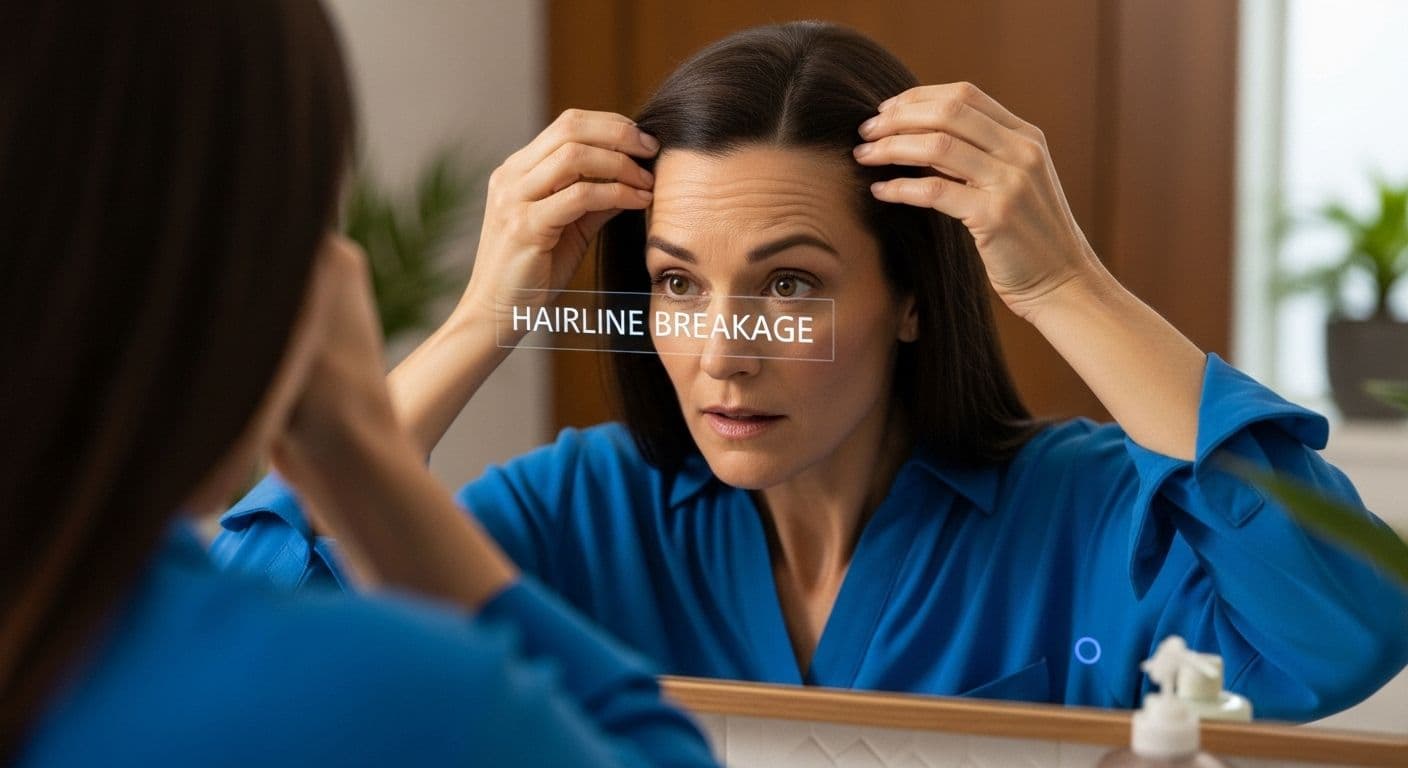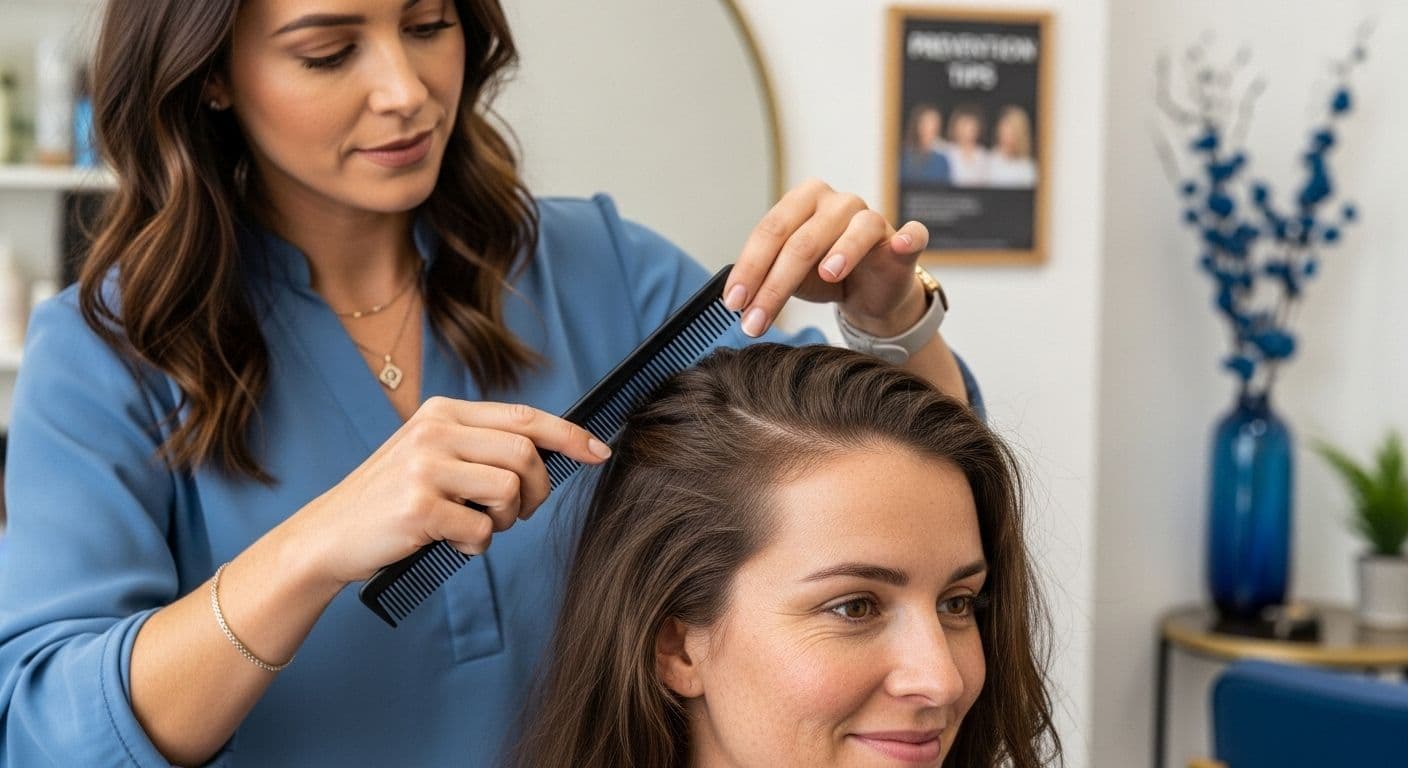Blog
Learning Materials
Understanding Hairline Breakage: Causes and Solutions
Updated: August 29, 2025

Hairline breakage is one sneaky problem that can strip away your confidence fast. Most people focus on hair loss across the scalp but those tiny broken hairs near your forehead and temples spell bigger trouble than you think. Studies show that certain hair types, especially Black hair with its elliptical shape, are more prone to mechanical breakage, and repeated tension or overstyling can set off long term damage. What most people miss is that those little broken hairs might be the first clue to deeper hair health issues hiding just beneath the surface.
Table of Contents
- What Is Hairline Breakage And How Does It Happen?
- Why Hairline Breakage Matters For Hair Health
- The Science Behind Hair Structure And Breakage
- Common Causes Of Hairline Breakage And Prevention
- Recognizing Hairline Breakage: Symptoms And Signs
Quick Summary
| Takeaway | Explanation |
|---|---|
| Understand the causes of hairline breakage | Identifying factors such as tight hairstyles and chemical treatments can help in recognizing potential damage. |
| Recognize visual symptoms early | Look for uneven lengths and flyaway strands to detect hairline damage before it worsens. |
| Implement preventive hair care strategies | Use gentle handling and avoid heat styling to maintain hair integrity and prevent breakage. |
| Address nutritional and hormonal factors | Nutritional deficiencies and hormonal imbalances may indicate underlying health issues that affect hair health. |
| Consult professionals for persistent issues | Seek medical advice if you notice ongoing hairline breakage, as it may signal more significant health concerns. |
What is Hairline Breakage and How Does It Happen?
Hairline breakage represents a specific form of hair damage targeting the delicate hair strands around your forehead and temples. Unlike typical hair damage, this condition specifically weakens and fractures hair at its most vulnerable points, creating visible thinning and potential long term hair loss risks.
The Structural Mechanics of Hair Damage
Hair is composed of keratin proteins with a complex internal structure that can become compromised through multiple mechanisms. Research from the National Institutes of Health indicates that mechanical stress plays a critical role in hairline breakage. The frontotemporal scalp region contains some of the most fragile hair follicles, making these areas particularly susceptible to damage.
Key factors contributing to hairline breakage include:
- Consistent tension from tight hairstyles
- Repeated chemical treatments
- Aggressive styling techniques
- Environmental stress factors
Root Causes of Mechanical Hair Damage
Hair breakage fundamentally occurs when external forces exceed the internal structural integrity of hair strands. Traction alopecia represents a prime example of this phenomenon, where repeated pulling and tension gradually weaken hair follicles. Learn more about preventing hair damage.
The unique geometry of hair follicles means that certain hair types particularly Black hair with its elliptical shape and helical structure are more vulnerable to mechanical damage. Chemical treatments like relaxers further compromise hair shaft strength, creating microscopic weaknesses that ultimately lead to unexpected breakage.
Understanding these intricate mechanisms helps individuals recognize and proactively address potential hairline damage before permanent follicle destruction occurs.
Why Hairline Breakage Matters for Hair Health
Hairline breakage transcends cosmetic concerns, representing a significant indicator of underlying hair and scalp health. This condition signals potential systemic issues that can compromise your hair's long term growth and overall structural integrity.
The Long Term Impact of Hair Follicle Damage
Research from the International Journal of Trichology reveals that persistent hairline breakage can trigger profound physiological disruptions. When hair strands continuously fracture, the delicate follicular ecosystem experiences cumulative stress that extends far beyond surface level damage.
Critical implications of ongoing hairline breakage include:
- Permanent reduction in hair density
- Potential irreversible follicle scarring
- Compromised natural hair growth cycles
- Increased vulnerability to future hair loss
Diagnostic Significance of Hairline Damage
Hairline breakage functions as an early warning system for broader health assessments. Explore advanced hair health strategies to understand how these seemingly minor indicators can reveal crucial insights.
Beyond aesthetic concerns, persistent hairline damage might signal nutritional deficiencies, hormonal imbalances, or underlying dermatological conditions. Thinning or repeatedly breaking hair along the frontal scalp region could indicate metabolic stress, protein malnutrition, or potential autoimmune responses that require professional medical evaluation.
Understanding these intricate connections empowers individuals to recognize hairline breakage not just as a cosmetic issue, but as a vital health diagnostic tool that demands proactive attention and comprehensive care.
The Science Behind Hair Structure and Breakage
Hair is a complex biological structure composed of intricate layers that interact dynamically with environmental and mechanical stressors. Understanding its fundamental architecture reveals why certain hair types are more susceptible to damage and breakage.
Anatomical Composition of Hair Fibers
Research from the National Center for Biotechnology Information explains that hair comprises three primary structural layers: the cuticle, cortex, and occasionally a medulla in thicker hair strands. The cuticle functions as a protective outer shield, consisting of overlapping scale-like cells that guard the inner hair components.
Key structural characteristics of hair include:
- Multilayered protein composition
- Complex keratin protein network
- Microscopic cellular interactions
- Unique geometric configurations
Mechanical Vulnerabilities in Hair Architecture
Hair's structural integrity depends on precise protein bonds and cellular alignment. Discover advanced hair protection techniques to understand how these microscopic interactions determine overall hair strength.
Chemical treatments and physical manipulation can systematically compromise these delicate protein structures. Repeated stress creates microscopic fractures within the hair shaft, weakening its internal framework and increasing susceptibility to unexpected breakage. The cuticle's scale-like arrangement becomes progressively damaged, exposing the more vulnerable cortical layer to further degradation.
Comprehending these intricate scientific mechanisms transforms hair care from a cosmetic concern to a nuanced understanding of biological structural engineering.
Understanding the structural components and characteristics of hair can help explain why certain areas, like the hairline, are more prone to breakage. The table below breaks down the features of each main hair structure layer discussed in the article.
| Hair Structure Layer | Key Features | Role in Hair Health |
|---|---|---|
| Cuticle | Outermost layer, scale-like overlapping cells | Shields inner hair from damage and moisture loss |
| Cortex | Thick middle layer, keratin proteins, main mass | Gives hair strength, elasticity, and color |
| Medulla | Central core (present in thicker hair types) | Increases diameter and bulk (not always present) |
| Protein Network | Multilayered keratin structure throughout | Provides overall hair structure and resilience |
| Geometric Shape | Varies by hair type (elliptical in Black hair) | Affects vulnerability to mechanical breakage |
Common Causes of Hairline Breakage and Prevention
Hairline breakage emerges from a complex interplay of environmental, mechanical, and physiological factors that systematically compromise hair's structural integrity. Understanding these diverse triggers is crucial for developing effective prevention strategies.
Environmental and Mechanical Stressors
Research from the International Journal of Trichology reveals multiple mechanisms contributing to hairline damage. Environmental exposure presents significant risks, with UV radiation, humidity fluctuations, and pollution creating cumulative stress on hair fibers.
Primary contributors to hairline breakage include:
- Excessive heat styling
- Tight hairstyling techniques
- Chemical processing treatments
- Improper hair maintenance routines
- Prolonged environmental exposure
Preventing Structural Hair Damage
Explore targeted hair protection strategies to minimize potential damage and maintain hair health. Preventive approaches require a holistic understanding of individual hair characteristics and targeted intervention techniques.
Mitigating hairline breakage demands a multifaceted approach that addresses both external stressors and internal hair health. Gentle handling, protective styling, minimizing chemical treatments, and using appropriate moisture balance techniques can significantly reduce the risk of ongoing hair damage. Understanding your specific hair type and its unique vulnerability factors becomes essential in developing personalized hair care protocols.

Recognizing these intricate mechanisms transforms hair care from reactive treatment to proactive preservation, empowering individuals to maintain robust and resilient hair growth.
Recognizing Hairline Breakage: Symptoms and Signs
Hairline breakage represents a nuanced hair condition characterized by specific visual and tactile indicators that distinguish it from traditional hair loss. Understanding these subtle signs enables early intervention and more effective hair care strategies.
Visual Markers of Hairline Damage
Research from the National Institutes of Health highlights distinctive visual characteristics that signal potential hairline breakage. These symptoms manifest through observable changes in hair texture, length, and overall appearance around the frontal scalp region.
Key visual indicators include:
- Uneven hair lengths around the hairline
- Visible shorter "flyaway" strands
- Frayed or rough hair edges
- Irregular hair contour at the forehead
- Increased fuzzy or wispy appearance
Diagnostic Characteristics of Hair Shaft Damage
Learn about advanced hair health assessment to understand the nuanced differences between breakage and typical hair loss. Hairline breakage differs fundamentally from complete hair loss, characterized by broken hair shafts rather than follicular detachment.
Diagnostic evaluation involves examining hair's physical characteristics during grooming and styling. Patients often notice increased hair shedding during brushing, with broken fragments appearing shorter and more irregular compared to naturally shed hair. The damage typically concentrates along high friction areas like temples, nape, and frontal hairline, where mechanical stress accumulates most intensely.

Recognizing these intricate symptoms transforms hair care from reactive management to proactive preservation, empowering individuals to address potential structural vulnerabilities before significant damage occurs.
Ready to Take Control of Hairline Breakage?
Do you keep spotting uneven, thinning strands at your hairline and feel concerned about the future of your hair health? Invisible breakage along your temples and forehead is more than a cosmetic frustration. It points to deeper issues—mechanical tension, structural hair weakness, and early warnings of potential long-lasting damage. The good news is you do not have to navigate this alone. MyHair.ai helps you spot subtle warning signs of hairline breakage quickly, turning knowledge into action. Our advanced AI technology assesses your unique hair structure, identifies breakage patterns, and delivers step-by-step solutions tailored just for you. No more guessing. No more waiting for visible damage before you act.

Start protecting your hairline today. Visit MyHair.ai and upload your scan to get a personalized hair health analysis. Discover your individual breakage risks, track real-time changes, and receive expert recommendations for products and routines targeted to your needs. Take the first step to restore confidence in your hair. The sooner you act, the more you protect your natural beauty. Learn more about our personalized assessments and begin your journey toward healthier hair right now.
Frequently Asked Questions
What is hairline breakage?
Hairline breakage refers to the damage occurring at the delicate strands of hair around the forehead and temples, leading to thinning and potential long-term hair loss risks.
What causes hairline breakage?
Hairline breakage can be caused by various factors, including tight hairstyles, excessive heat styling, repeated chemical treatments, environmental stress, and improper hair maintenance routines.
How can I prevent hairline breakage?
To prevent hairline breakage, consider gentle handling of your hair, opting for protective hairstyles, minimizing the use of heat tools, and reducing chemical treatments. Maintaining a healthy moisture balance in your hair is also crucial.
What are the visual signs of hairline breakage?
Visual signs include uneven hair lengths around the hairline, shorter "flyaway" strands, frayed hair edges, a fuzzy appearance, and visible irregular contours at the forehead. These indicators suggest potential hairline damage.